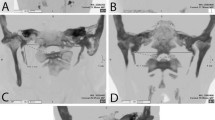Abstract
The aim of this study is to investigate the frequency of the SHC variations, and the distribution of the SP lengths in different age and sex groups using MDCT. MDCT scans were performed in 805 patients (401 males, 404 females). The patients were divided into six groups according to their ages. The length of the styloid process (SP) and its angulation on the transverse (TA) and sagittal (SA) planes were measured. Structural variations of the SHC were observed by means of three-dimensional (3D) and multiplanar reconstruction (MPR) images. Absence of the styloid process (n = 10), double proximal origin (n = 13), segmentation (n = 223), complete ossification (n = 24), and an SP with three proximal parts in one patient were among the anomalies detected. The mean length of the SP was greater in males than in females (33.2 ± 13.2 vs. 29.6 ± 10.5 mm, P < 0.001). Elongated SP (ESP) was observed in 56 % of the patients in the study group, and this ratio was the highest in Group 3 with 65.4 % (P < 0.05). TA and SA were 70.2° ± 4.1°, 69.9° ± 4.2° and 86.6° ± 6.5°, 88.3° ± 6.6° for the right and left sides, respectively. Besides, 3D and MPR images also present detailed and reliable data to radiologists and surgeons for the evaluation of the SHC. ESP has been detected in more than half of the patients, being more frequent in males and in individuals in the fifth decade of life. For an accurate diagnosis, clinicians should consider the ESP while evaluating the patients in this age group.







Similar content being viewed by others
References
O’Carroll MK (1984) Calcification in the stylohyoid ligament. Oral Surg Oral Med Oral Pathol 58:617–621
Onbaş O, Kantarcı M, Karasen RM et al (2005) Angulation, length, and morphology of the styloid process o the temporal bone analyzed by multidetector computed tomography. Acta Radiol 8:881–886
Ramadan SU, Gökharman D, Koşar P et al (2010) The stylohyoid chain: CT imaging. Eur J Radiol 75:346–351
Basekim C, Mutlu H, Gungor A et al (2005) Evaluation of styloid process by three dimensional computed tomography. Eur Radiol 15:134–139
Gözil R, Yener N, Çalgüner E, Araç M, Tunç E, Çelioflu M (2001) Morphological characteristics of styloid process evaluated by computerized axial tomography. Ann Anat 183:527–535
Ramadan SU, Gökharman D, Tunçbilek I, Kacar M, Koşar P, Koşar U (2007) Assessment of the stylohyoid chain by 3D-CT. Surg Radiol Anat 29:583–588
Kaufman SM, Elzay RP, Irish EF (1970) Styloid process variation radiologic and clinical study. Arch Otolaryngol 91:460–463
Ceylan A, Köybaşioğlu A, Celenk F, Yilmaz O, Uslu S (2008) Surgical treatment of elongated styloid process: experience of 61 cases. Skull Base 18:289–295
Yavuz H, Caylakli F, Yildirim T, Ozluoglu LN (2008) Angulation of the styloid process in Eagle’s syndrome. Eur Arch Otorhinolaryngol 265:1393–1396
Ghosh LM, Dubey SP (1999) The syndrome of elongated styloid process. Auris Nasus Larynx 26:169–175
Jung T, Tschernitschek H, Hippen H, Schneider B, Borchers L (2004) Elongated styloid process: when is it really elongated? Dentomaxillofac Radiol 33:119–124
Palesy P, Murray GM, De Boever J, Klineberg I (2000) The involvement of the styloid process in head and neck pain: a preliminary study. J Oral Rehabil 27:275–287
Rath G, Anand C (1991) Abnormal styloid process in a human skull. Surg Radiol Anat 13:227–229
Beder E, Ozgursoy OB, Ozgursoy SK (2005) Current diagnosis and transoral surgical treatment of Eagle’s syndrome. J Oral Maxillofac Surg 63:1742–1745
Prasad KC, Kamath MP, Reddy KJM, Raju K, Agarwal S (2002) Elongated styloid process (Eagle’s Syndrome): a clinical study. J Oral Maxillofac Surg 60:171–175
Satyapal KS, Kalideen JM (2000) Bilateral styloid chain ossification: case report. Surg Radiol Anat 22:211–212
Eagle W (1937) Elongated styloid process: report of two cases. Arch Otolaryngol 25:584–586
Ferrario VF, Sigurta D, Daddona A et al (1990) Calcification of the stylohyoid ligament: incidence and morphoquantitative evaluations. Oral Surg Oral Med Oral Pathol 6:524–529
Savranlar A, Uzun L, Ugur MB, Ozer T (2005) Three-dimensional CT of Eagle’s syndrome. Diagn Interv Radiol 11:206–209
Baugh RF, Stocks RM (1993) Eagle’s syndrome: a reappraisal. Ear Nose Throat J 72:341–344
Fini G, Gasparini G, Filippini F, Becelli R, Marcotullio D (2008) The long styloid process syndrome or Eagle’s syndrome. J Craniomaxillofac Surg 28:123–127
Strauss M, Zohar Y, Laurian N (1979) Elongated styloid process syndrome: intraoral versus external approach for styloid surgery. Laryngoscope 95:976–979
Chase DC, Zarmen A, Bigelow WC, McCoy JM (1986) Eagle’s syndrome: a comparison of intraoral versus extraoral surgical approaches. Oral Surg Oral Med Oral Path 62:625–629
Conflict of interest
The authors declare that they have no conflict of interest.
Author information
Authors and Affiliations
Corresponding author
Rights and permissions
About this article
Cite this article
Ekici, F., Tekbas, G., Hamidi, C. et al. The distribution of stylohyoid chain anatomic variations by age groups and gender: an analysis using MDCT. Eur Arch Otorhinolaryngol 270, 1715–1720 (2013). https://doi.org/10.1007/s00405-012-2202-5
Received:
Accepted:
Published:
Issue Date:
DOI: https://doi.org/10.1007/s00405-012-2202-5




